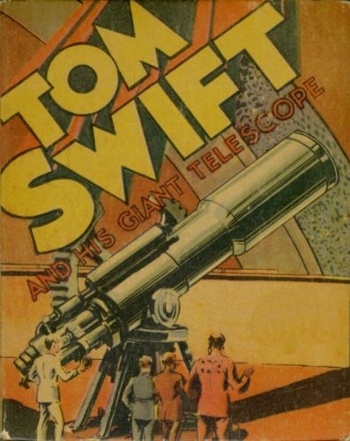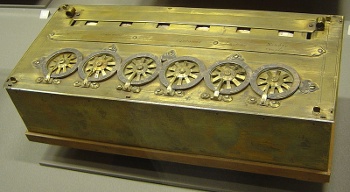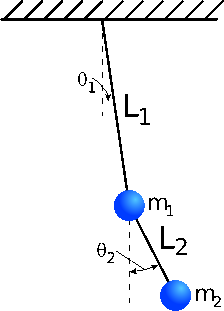Teen Scientists
February 1, 2013
I had a home
laboratory while in
grammar school and
high school. When I started my career as a professional
scientist, I found that many of my colleagues had one as well. More than half my science education came from tinkering and independent study. One of my most prized possessions when I was a
fifth grader was a complete
doorbell circuit composed of a hefty
battery, a
switch, a
bell, and
wire. I also used the battery to power
electromagnets I made from wire coiled on
steel nails.
The doorbell components were a gift from my
parents, who would also give me
science kits, such as the traditional
chemistry set and an
Erector set. A
toy train set was more prized for its variable
transformer than its actual purpose. The transformer had enough power to heat fine wires to
incandescence.
There are a few science kits sold today, but most of these are rather tame compared with the ones I had as a child. As I wrote in a
previous article (Baking Soda and Vinegar, October 8, 2010),
regulatory agencies are making it harder to sell children's toys, and such kits have become more expensive. Nowadays, it's easier to market science-themed
computer programs. Most of these have flashy
animations and
hip background music, but they are a poor second to hands-on experience.
One thing that encouraged my home experimentation was the annual science fair we had from sixth grade through high school. These were a lot of fun, and they were a great learning experience. You can view a photograph of the radio telescope antenna I made as part of my science fair entry during my senior year of high school, here.

Cover of the 1939 book, Tom Swift and His Giant Telescope.
One of my high school classmates built his own twelve-inch Newtonian reflector as high science fair project. Most of his time was spent hand-polishing the glass blank for the mirror and checking his progress using a razor blade in the traditional Foucault knife-edge test.
(Slightly modified Wikimedia Commons image)
Another thing that got me interested in science as a youth was science books, starting with the various "
Golden Books,"[1] and graduating to young
science fiction books, such as the
Tom Swift, Jr. series. The Tom Swift books I read were a modernization of the original series, which featured
Tom's father. The many space-themed movies of that era were also an inspiration.
Wikipedia has a listing of all titles in the second Tom Swift series. I remember reading the following:
• Tom Swift and His Flying Lab (1954)
• Tom Swift and His Rocket Ship (1954)
• Tom Swift and His Giant Robot (1954)
• Tom Swift and His Atomic Earth Blaster (1954)
• Tom Swift and His Outpost in Space (1955)
• Tom Swift in the Caves of Nuclear Fire (1956)
• Tom Swift on the Phantom Satellite (1956)
This sudden
nostalgia was brought on by a short
blog article by Ken Myers in
Scientific American.[2] He lists the following examples of scientists who started doing science in their
teen years.
• Aristotle
• Galileo Galilei
• Blaise Pascal
• Isaac Newton
• Albert Einstein
All these were surely
prodigies, but I would say that good evidence only exists to qualify Galileo and Pascal as having done science in their teen years. There's somewhat of an Einstein
cult, at least among
popular science writers, that requires a mention of Einstein in any story about awkward science prodigies.
Einstein was rightly famous in later years, but there's no evidence of his being a "teen scientist." Starting in his teens, Aristotle was tutored by
Plato, but he was a
student at that time, not a scientist. Newton in his teens was also a student, and not a scientist.
For Pascal, the evidence is clear. At age sixteen, Pascal discovered
Pascal's theorem about a property of
line segments joining arbitrary
points on a
conic section, such as an
ellipse,
parabola or
hyperbola. At age nineteen, Pascal invented a
mechanical calculator, called the
Pascaline, as an aid for his father, who was a
commissioner of
taxes.

A Pascaline at the Musée des arts et métiers, Paris
(Photograph ©2005, David Monniaux, via Wikimedia Commons.)
Likewise, Galileo, in 1581 at age seventeen, made his famous observation about the swing of
pendula, that the
period is independent of the
amplitude. He followed up on this observation by doing
experiments. Galileo is known as the Father of experimental
physics. Although his father preferred that Galileo should become a
physician, Galileo talked his father into allowing his career change from medical school to
science and
mathematics.

Not your ordinary Renaissance pendulum
Galileo would have had a difficult time analyzing the motion of a double pendulum, which exhibits chaotic motion under certain conditions.
(Image by JabberWok, via Wikimedia Commons.)
One scientist who definitely was doing science in his teens was
physicist,
John D. Kraus, whom I briefly mentioned in a
previous article (Optical Antennas, June 13, 2011). Kraus is the inventor of the
axial mode helical antenna, and he was a pioneer in
radio astronomy.
As recalled in Kraus'
autobiographical book, Big Ear,[3] he had a home laboratory as a child. In 1920, at age ten, he built a
crystal radio and used the receiver from his family
telephone as an improvised
headphone. He built
transmitters and
radio receivers in the early days of
radio, at one time building a
high voltage electrolytic rectifier using 48
Mason jars with
aluminum and
lead electrodes and a
borax-
water electrolyte. To do this, he collected rainwater for the solutions, since it had fewer
impurities than the city water supply.[3]
References:
- The Golden Book of Chemistry Experiments by Robert Brent and illustrated by Harry Lazarus, is available, as a PDF file, here. As explained in the article, Banned Book - The Golden Book of Chemistry Experiments by Anne Marie Helmenstine (August 5, 2008), some of the experiments are dangerous, and the book was banned from libraries. It's still a fun read for adults. As they say, "Adult supervision is required."
- Ken Myers, "5 Famous Scientists That Started Their Work as Young Teens," Scientific American, January 17, 2013.
- John Kraus, "Big Ear," Cygnus-Quasar Books (Powell, Ohio, 1976).
Permanent Link to this article
Linked Keywords: Laboratory; grammar school; secondary education in the United States; high school; scientist; fifth grader; doorbell; circuit; battery; electric switch; electric bell; wire; electromagnet; steel; nail; parent; educational toy; science kit; chemistry set; Erector set; toy train set; transformer; incandescence; regulatory agency; educational software; computer program; animation; video game music; background music; experiment; experimentation; science fair; sixth grade; radio telescope; antenna; twelfth grade; senior year of high school; Newtonian reflector; Foucault knife-edge test; Wikimedia Commons; The Golden Book of Chemistry Experiments; Golden Books; science fiction; Tom Swift, Jr.; Tom Swift; Tom's father; nostalgia; blog; Scientific American; adolescence; teen years; Aristotle; Galileo Galilei; Blaise Pascal; Isaac Newton; Albert Einstein; child prodigy; cult; popular science; Plato; student; Pascal's theorem; line segment; point; conic section; ellipse; parabola; hyperbola; mechanical calculator; Pascaline; commissioner; tax; Musée des arts et métiers; Paris; pendulum; frequency; period; amplitude; physics; physician; science; mathematics; Renaissance; double pendulum; chaos theory; chaotic; JabberWok; physicist; John D. Kraus; axial mode helical antenna; radio astronomy; autobiography; crystal radio; telephone; headphone; transmitter; radio receiver; radio; high voltage; electrolytic rectifier; Mason jar; aluminum; lead; electrode; borax; water; electrolyte; impurity.